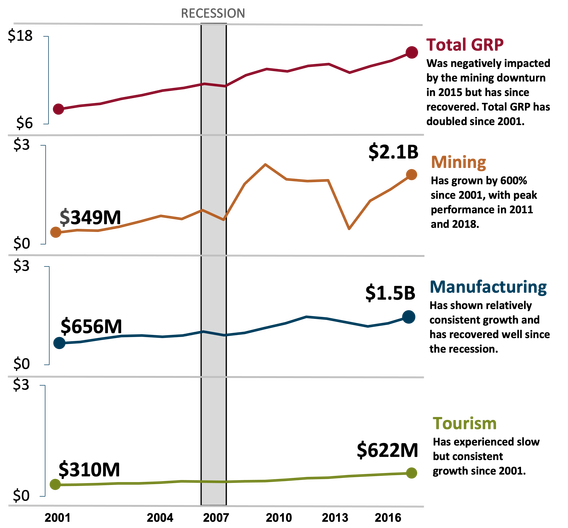10. The State of Labor in Minnesota Shown in Five Charts (October 27)
Current BBER undergraduate research assistant (UGRA) Ben Palmquist examined the state of the local labor market in five visualizations, covering topics such as the unemployment rate, weekly wages, income by race, and union participation—a post that was originally inspired by a Minnesota Reformer article on the state of the national labor market.
9. Nathan Brand reflects on Fall 2020 REIF Presentation (February 18)
As he prepared for his upcoming graduation, former UGRA Nathan Brand reflected on one of his most memorable achievements during his time at the BBER—presenting at the (first ever) virtual Regional Economic Indicators Forum (REIF) in fall 2020. “It’s a great experience actually presenting to a large crowd instead of just a class. It’s much more indicative of the real world. If you are asked to do a presentation, you won’t be given a rubric, so being confident in how to structure and deliver your research is essential.”
8. Economic Impacts of the Child Tax Credit (July 22)
As families began to see child tax credits reach their bank accounts, the BBER estimated the economic impacts of these credits on the local economy. In total, the payments would equal more than $35 million over the course of the year, and the stimulus could create 236 new jobs in the county. This blog post was picked up by numerous local media outlets.
7. GRP Visualized Easily (May 20)
Prior to his graduation in 2020, former UGRA Matthew Hockert wrote this interesting blog post, which we published the following spring, showing the process he used to create a data visualization for our ferrous and nonferrous mining study.
6. The Benefits Cliff Dilemma (February 4)
Former UGRA Brand explained the phenomenon known as the benefits cliff, which occurs when an increase in an individual’s income leads to a decrease in their social assistance payments. The situation creates a disincentive to accept a promotion or higher wage. Brand created visualization to easily show this for St. Louis County. Our office has since updated the visualization for St. Louis County using more accurate data on child care benefits, and has created a similar visualization for the city of Minneapolis.
5. Duluth’s Housing Trends (September 16)
Statewide news coverage on Duluth’s housing market inspired this post, which examined the number of new housing units added in the city since 2016 and how those numbers compare with other mid-sized Midwest cities. We found that while Duluth has stepped up the number of new housing units in recent years, most of the growth has been in multi-family housing. Compared to other Midwest cities, Duluth added fewer new housing units than Fargo, Rochester, Rapid City, and Eau Claire, but more than Green Bay, St. Cloud, Appleton, and Waukesha.
4. Q&A with BBER research assistant Daniel Ye (October 14)
This post introduced readers to former UGRA Daniel Ye, just before his presentation at the October REIF. Daniel discussed preparing for the REIF, living in Duluth, his plans after graduation, and his best experience as a UMD student. “All the professors I have met at UMD are passionate, amiable, and always willing to offer help—either in your studies or life. They come from various areas and cultures, providing a diversity of experiences and viewpoints.”
3. Investigating Duluth as a Climate Refuge (July 29)
This post, written by UGRAs Palmquist and Ye, summarized recent media coverage labeling Duluth as a climate refuge. Since that post, the BBER has conducted nearly 20 stakeholder interviews on the topic of climate migration to Duluth and what it might mean for the city. Notably, this post also prompted an interview request from E&E News for a story on the same subject. The BBER’s final report will be out this spring.
2. Economic Impacts of Growth in Duluth’s Tourism Industry (August 19)
The city of Duluth announced plans to outsource its tourism marketing to Minneapolis-based firm, Bellmont Partners. In response, we revisited our 2020 analysis on the city's tourism industry to see what 0.5%, 2%, or 4% growth in the city's tourism industry (over 2019 levels) could mean for the city's economy.
1. Checking in with former BBER intern – Matthew Hockert (July 8)
We touched base with former UGRA Hockert, who is working towards completing his Master’s degree in Applied Economics at the University of Minnesota – Twin Cities campus to see what his journey has been like since leaving the BBER. The post was shared on both UMD’s social media sites as well as by the College of Food, Agriculture, and Natural Sciences (CFANS) at the UMTC, making it our most popular post of the 2021.
If you have an idea for a 2022 blog post, give us a shout via email or through LinkedIn. And thank you for following us.

